Yesterday, over 80 people showed up for the
Growing Bread Locally workshop, which was well over the expectations of the organizers. They’d initially expected a smaller audience of farmers and bakers but were pleasantly surprised to see so many consumers take an interest in local wheat and local wheat products.
Once everyone signed in and checked out the literature and grain samples, the organizers made their introductions. Al Earnhart is the farm manager at Lightning Tree Farm. Jeanine Connolly is also from Lightning Tree. Eli Kaufman is with the Wheat Heritage Conservancy. Elizabeth Dyck from NOFA-NY is the coordinator of the Northeast Organic Wheat Project. Don Lewis is the owner of Wild Hive Farm, a micro-mill and bakery exclusively using local grains.
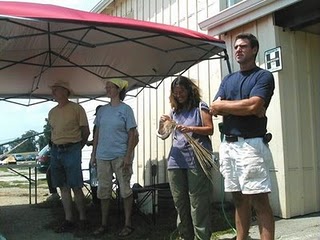
Left to Right: Don Lewis, Jeanine Connolly, Eli Kaufman, Al Earnhart
Al Earnhart gave us a demo of the combine, an indispensable machine in wheat farming. A combine, according to Wikipedia is “a machine that combines the tasks of harvesting, threshing, and cleaning grain crops.” First you drive the combine around the field to harvest the wheat. Then the combine threshes the wheat, separating the grain from the straw. The straw is left on the field as compost. Then there are multiple phases of cleaning and filtering. We saw a demo of the seed cleaner, where screen sizes are based on the grain as well as the year. Then there is the drying. The wheat must be dried properly to prevent molding yet retain viability. Once dry, grains destined for human consumption are stored in a metal-lined storage facility.
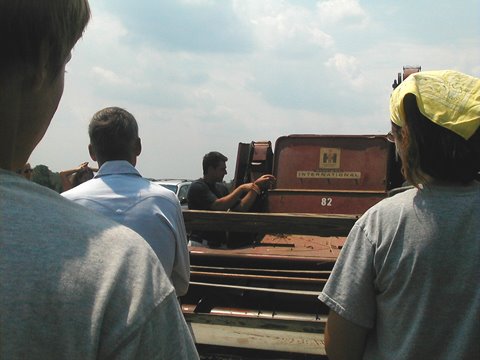
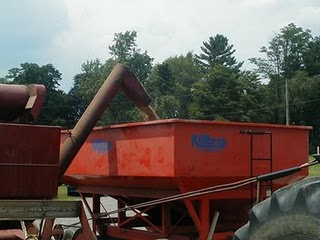
Lightning Tree Farm uses the COWS method of farming. They rotate corn, oats, wheat, and sod (clover) on each field in the 425 acres. In the late 1700s, wheat was over-farmed on this land until the soil could no longer produce anything. Those farmers moved west. Today, because of these sustainable farming practices, the land is fertile and able to produce wheat once again.
Elizabeth Dyck spoke about the Northeast Organic Wheat Project, which among other things is looking for folks to keep the heritage seeds going simply by growing the wheat and saving the seeds. Eli Kaufman travels the world researching and growing wheat. She spoke of the resurgence of some of the ancient wheat, such as emmer and spelt.
Then we got to the audience participation portion of the program. Don Lewis (of Wild Hive Farm) brought his mobile oven and baked bread samples with AC Barrie, Triticale, Frederick (soft white winter), and Red Fife wheat. His oven is his own design, crafted by Fletcher Coddington of Arrowsmith Forge. It is a mobile, wood-fired hearth oven. It has seven dampers to control the hot spots. It is a thing of engineering beauty indeed.
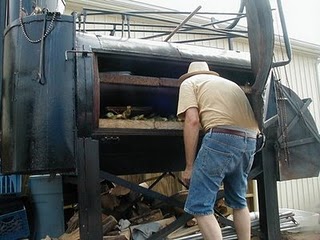
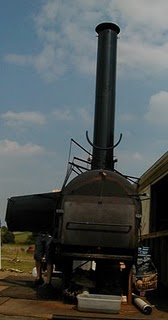
The bread was delicious. It was interesting to taste the differences between the different grains. It was intensely satisfying to finally eat bread made from local wheat. The butter was out of this world, locally made and as far as I know, not commercially available. Oh yeah, we had corn on the cob too, roasted in Don’s oven.
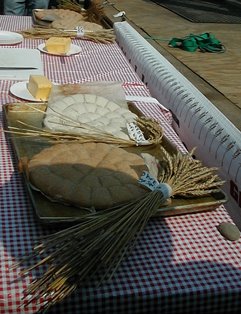
I left the event with a ton of information, several bags of flour and grains, a loaf of bread, and great hope for the future.
For those looking to do something, here are some actions you can take:
Farmers and Gardeners: “adopt-a-crop” of rare heritage wheat, trial commercial wheat varieties and partner with local bakers
Artisan Bakers: work with local farmers to test wheat varieties for flavor and baking quality
Regular People: Buy and eat the products created by the artisan bakers. Buy the grains and flours and experiment with some recipes of your own.
Contacts:
Elizabeth Dyck
Eli Kaufman
Resources:
Heritage Wheat Conservancy
SARE (Sustainable Agriculture Research and Education)
Footnote:
In case you want to grow your own wheat, here’s the math to produce one loaf of bread per day. Consider that it takes about 1-1/2 lbs of sifted milled flour to make the loaf. Since you lose about 20% of your weight in the sifting, you need to mill about 1-7/8 lbs of grain. In a year, you’d need 685 lbs of grain. If you save and sow your own seeds, the ratio of seeds to yield is 1:10, so you need to produce 760 lbs of wheat to take some seed off the top for planting. You can get about 900 lbs of grain from 1/2 an acre. So, you’d need to plant just under 1/2 and acre to make a loaf of bread a day.





